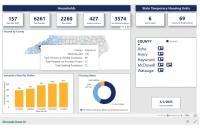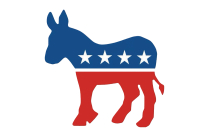Cherokee adopts Baker Roll list as basis for tribal membership
Blood quantum. Even on their own, the words have a ceremonial, reverent ring to them.
For Cherokee tribal members, reality bears out the ring. Blood quantum — the fraction of one’s ancestry that is purely Cherokee — decides everything from a person’s ability to own land in the Qualla Boundary to availability of scholarships for college to eligibility to receive a share in casino profits each year.
The EBCI enrollment audit at a glance
What is the enrollment audit?
A review of the nearly 14,000 people on the tribe’s roll to determine whether they qualify as being Cherokee. The Eastern Band of Cherokee Indians requires members to be one-quarter Cherokee by blood and to have a direct link to the Baker Roll of 1924.
An outside firm, The Falmouth Institute, was hired to do the audit. So far, the Cherokee have spent $746,000 on the audit, with another $100,000 budgeted for its completion, which is slated for September.
What is the Baker Roll?
The final roll of the Eastern Cherokee, prepared by United States Agent Fred A. Baker, in 1924. Termination of the Tribe as a government and political entity was the ultimate goal of the Congressional act that initiated the Baker Roll. After termination efforts failed, the Tribe continued to use the 1924 Baker Roll as its base roll. Descendants of those persons of the original Baker Roll are enrolled on the Baker Revised Roll, providing they meet the membership requirements of the Tribe.
What did the audit find?
The report found 2,251 “actionable” files, meaning that some action needed to be taken to correct their status. Most were only minor incongruities that were easily cleared up.
The audit turned up only 303 tribal members with no direct link to the Baker Rolls, the majority of them the result of missing birth certificates.
Perhaps the most crucial number turned up by the audit was the 50 enrolled members who were revealed to have insufficient blood quantum levels to meet the enrollment requirements.
What’s at stake?
Enrollment bring with it a host of benefits, including the right to own land in the Qualla Boundary and about $8,000 a year per person in shared casino revenues.
Cherokee enrollment quandary leads to talk of DNA testing
The Eastern Band of Cherokee Indians is talking about moving to DNA testing as a way of verifying the blood requirement to be enrolled as a tribal member.
The tribe’s latest quandaries over its enrollment audit have led Principal Chief Michell Hicks and a number of members of the Tribal Council to point to DNA testing as the way forward when enrolling new members of the tribe.
“Going forth DNA is the only way to correct this issue. I’ve said this from day one,” Hicks said. “Council has control over the enrollment process. The chief’s office doesn’t have any control here. But that’s always been my recommendation. If we want to get it right, let’s get it right, going forward with the DNA process.”
Making DNA testing mandatory for those who want to be included on the tribe’s rolls became the focal point of discussion at a Tribal Council meeting earlier this month. The conversation ensued after two enrolled members from the Snowbird community asked the tribe to stop enrolling new members until the auditing process had been completed.
The Tribal Council received the results of the enrollment audit in October. Since that time, an enrollment committee has worked on implementing the policies and procedures that would allow the tribe to proceed with disenrolling tribal members who don’t meet enrollment requirements.
The auditors report showed that 50 people on the rolls don’t meet the blood degree to qualify as a member of the tribe. Another 303 people on the rolls can’t prove they have an ancestor on the Baker Roll, a 1920s-era federal roster of tribal members considered a litmus test for enrollment today.
Even the Baker Roll is a contested issue. When the roll was adopted in 1924, the Tribal Council approved 1,924 names and challenged 1,222 names on the 3,146-person list.
Big Cove Representative Theresa McCoy said the audit can’t be considered complete until the council acts on the findings of the consulting firm that conducted the study.
“The process included the removal of the names of persons who do not meet the criteria for enrollment when they were enrolled, so to me, the enrollment audit is not complete,” McCoy said. “The paperwork is, the findings are, but the audit is not.”
While the enrollment audit was approved by a vote of tribal members in 2002, it was not until 2006 that the Falmouth Institute, an outside consulting firm, began its work. The Tribal Council is scheduled to vote on the policies and procedures it will use to enforce the results at its June meeting and the process could be complete as early as September.
The painstaking and lengthy audit has led some sitting council members to push for the use of DNA testing in the future.
“Let’s start doing DNA. We’ve got that technology, and we need to utilize it. Instead of putting people on that aren’t supposed to be,” said Snowbird Representative Diamond Brown.
The tribe has enrolled 157 new members, mostly infants, since last June. At its meeting earlier this month, the Tribal Council voted to pass an amendment that would prevent any new members, except those ages 0 to 3 and 18 to 19, to enroll until the audit process is complete.
One of the major issues concerning the tribe’s rolls centers on the right to per capita payments. Every tribal member gets two checks a year as a share of casino revenue. It amounts to about $8,000 a year. Per capita payments will be released to members on June 1.
Snowbird Representative Adam Wachacha said a complete enrollment audit and DNA testing were the only ways to save the tribe from repeating the painstaking review process again in the future.
“The people want the rolls to be cleaned up and unless we fix the process which we’re at, 20 years from now we’ll be in the same boat we are in now,” Wachacha said.
Hawk Brown, an 18-year-old enrolled member from Painttown, said DNA testing could make for painful realizations for some families.
“Everybody’s got skeletons in their closets. But if we want to clean this up, the people voted on it and that’s what they want to do,” Brown said. “Them things will have to brought out. Them things will have to be brought out in my own family.”
The Tribal Council will vote on the issue of whether to include DNA testing as an enrollment requirement and on policies and procedures governing disenrollment hearings in June.
Enrollment audit a slow, uneasy process for Cherokee
In a 2002 referendum, the members of the Eastern Band of Cherokee Indians voted to authorize an audit of the tribe’s enrolled members. Almost eight years later, the process is coming to a head as the Tribal Council considers how to use the findings of the study.
The primary issue facing the council is what to do about the 300 names the audit showed to have no connection with the Baker Roll, the tribe’s benchmark for enrollment qualifications.
“The Cherokee people are currently working through the procedures and policies to be set in place to deal with these individuals,” said Principal Chief Michell Hicks. “This is a difficult situation for us all, but a necessary step to ensure we are all in compliance with the Eastern Band’s enrollment guidelines.”
After perusing 18,000 files and more than 115,000 documents, the staff of The Falmouth Institute presented the final enrollment audit report to the Tribal Council last October. Now the council is charged with setting the policies and procedures that will be used to implement the findings.
The auditors found 1,405 files they deemed actionable, 683 files that did not meet the current enrollment requirements, and 300 people with no connection to the Baker Roll
At stake is not just who can be considered a member of the tribe, but also the benefits and rights that come with recognition as a tribal member, including the right to own land in the Qualla Boundary and the right to per capita payments. There are currently about 13,000 enrolled members of the Eastern Band of Cherokee.
During committee meetings last month, tribal council members considered the possibility of taking land back from disenrolled members and asked their legal team whether they would have to provide compensation for it.
EBCI Attorney General Annette Tarnawsky said the Pechanga Tribe in California and the Saginaw Chippewa Tribe of Michigan are in the midst of similar enrollment verification proceedings, but neither has used the enrollment audits to expel people from their reservations or to repossess land.
Jennifer Bainbridge, a tribal attorney in charge of researching the issue, said the lack of precedents makes for slow going, but that property rights issues would be the sticking point.
“There’s not any case law out there about tribes who have disenrolled people and taken their property,” Bainbridge said.
As complicated as it is, figuring out how to enforce the enrollment audit may prove simpler than determining how to interpret it.
Tribal Council member Terri Henry, who represents the Painttown community, pointed to the fact that the original Baker Roll was a contested document. When the roll was adopted in 1926, the Tribal Council approved 1,924 names and challenged 1,222 names on the 3,136-person list. For Henry, that fact shows that even at that point the tribe felt its membership should be a smaller group than the one the federal government recognized.
“To me, this kind of answers the question about the body politic at the time,” Henry said. “This was actually at the time the roll was enacted. This would be at the genesis moment of the enrollment of the tribe.”
The dispute over the Baker Roll can be traced to the fact that it was a document that relied on land records belonging to William Thomas, who facilitated the purchase of the land used to establish the Qualla Boundary. According to Tarnawsky, the Baker Roll “was derived from landholdings of Cherokee enrolled members who either sold or gave land to Mr. Thomas that then became part of the boundary.”
The Thomas papers date to the 1840s.
The difficulty of verifying all of the records available to the Cherokee that could establish enrollment criteria was made evident when David Wyatt, head of the tribe’s GIS mapping program, began discovering historic documents during his research of land tracts.
“In the process of scanning all that information at BIA, we came across a little bit of everything,” Wyatt said
Wyatt found original copies of Thomas’ records, census records from as early as 1912, and a 1967 revised version of the Baker Roll, among other documents. None of these were included in the enrollment audit conducted by Falmouth, and their staff indicated to Tarnawsky that the scope of their project would be limited to records in the possession of the tribe’s enrollment office.
So far, the Cherokee have spent $746,000 on the audit, with another $100,000 budgeted for its completion. But with the discovery of new records that could be pertinent to the effort, it’s not clear when the job will be done.
Tribal Council member Teresa McCoy was clear in the meeting last month that her constituents want closure.
“I do prefer that there be a deadline placed on this. Let’s not let it drag out for another six months. Our community met last week, and they were adamant. They were ready to start the next morning. They are tired of waiting. They have waited for seven years, and they don’t know what’s taking so long,” McCoy said.
But the council will have to decide whether to push disenrollment proceedings on the list of 300 or on a broader group identified by the audit.
With a vocal part of the membership clamoring for resolution, the council will have to negotiate intricate legal issues in addition to sorting out how to deal with records in possession of the Bureau of Indian Affairs and the State of North Carolina that could shed light on the status of enrollment claims.
Tribal Council member Tommye Saunooke asked for patience.
“I think the public needs to understand that the results of the audit did not come back to the council until late 2009. Council has not drug their feet on this,” Saunooke said.





